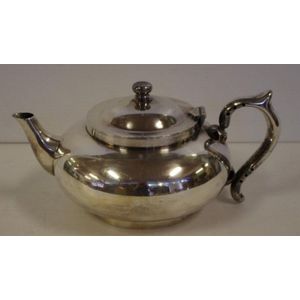Victorian Silver Teapot with Shell Decoration
You must be a subscriber, and be logged in to view price and dealer details.
Subscribe Now to view actual auction price for this item
When you subscribe, you have the option of setting the currency in which to display prices to $Au, $US, $NZ or Stg.
- Victorian Period - The Victorian period of furniture and decorative arts design covers the reign of Queen Victoria from 1837 to 1901. There was not one dominant style of furniture in the Victorian period. Designers used and modified many historical styles such as Gothic, Tudor, Elizabethan, English Rococo, Neoclassical and others, although use of some styles, such as English Rococo and Gothic tended to dominate the furniture manufacture of the period.
The Victorian period was preceded by the Regency and William IV periods, and followed by the Edwardian period, named for Edward VII (1841 ? 1910) who was King of the United Kingdom and the British Dominions and Emperor of India for the brief period from 1901 until his death in 1910. - Knop (silver) - A knop on a silver item is either a bulbous protrusion mid way along a stem, such as on a candlestick or at the end of a stem, such as on a spoon, or a knob or finial on top of a cover or lid, that acts as a handle. On a stemmed item such as a candlestick there may be a series of knops of different shapes.
- Scallop / Shell Motif - The shell motif has been used in furniture and decorative arts for centuries. In ancient Greece and Rome, shells were often used as decorative elements on furniture and in mosaics. The scallop or cockleshell are the most commonly used. During the Renaissance, the shell motif became popular in furniture and architecture, as the ornate decoration was seen as a symbol of wealth and luxury. In the 18th century, the Rococo style of furniture and decorative arts featured an abundance of shell motifs, and it was used by Thomas Chippendale and as a feature on Queen Anne style cabriole legs. In the 19th century, the shell motif was incorporated into Victorian furniture and decorative items, and often a representation of the the conch shell was inlaid into furniture.
This item has been included into following indexes:
Visually similar items

Victorian sterling silver teapot by Elkington & Co part fluted oval shape Birmingham 1883

A sterling silver teapot, early 20th century, Canadian, with maker's stamp for Birks. Of classical Adams design, the slightly bulbous boat shaped pot having broad bands to the upper body and base, with a curved spout, an oval domed lid, a timber bracket ha

Vintage silver plated 'Perfect' teapot

A George IV silver teapot, oblong, with gadrooned rim, on ball feet; ebonized handle; Crispin Fuller, London 1822. Weight (all in) approx 545g
